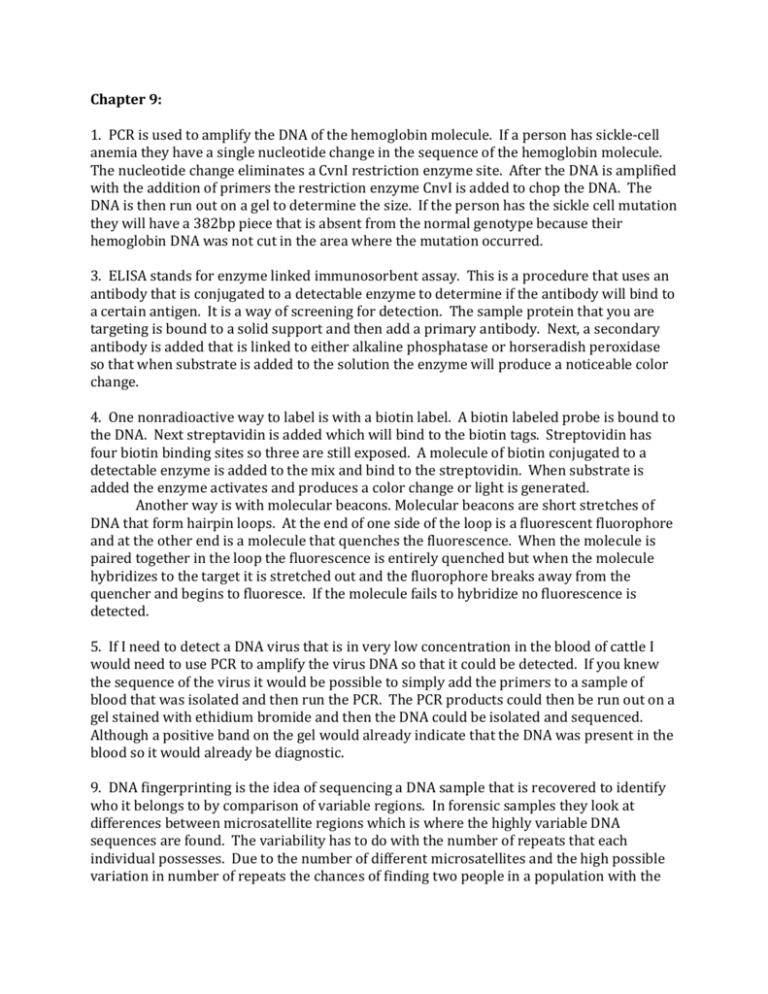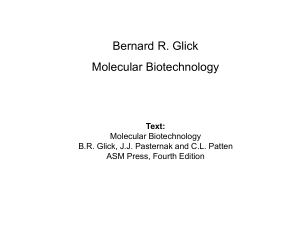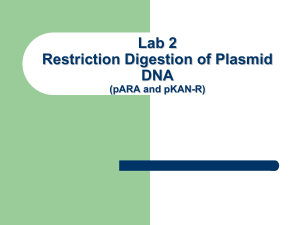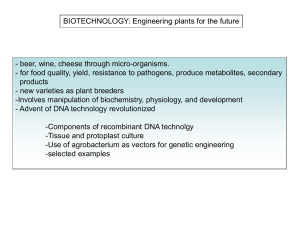Chapter 9 & 10 Homework
advertisement

Chapter 9: 1. PCR is used to amplify the DNA of the hemoglobin molecule. If a person has sickle-cell anemia they have a single nucleotide change in the sequence of the hemoglobin molecule. The nucleotide change eliminates a CvnI restriction enzyme site. After the DNA is amplified with the addition of primers the restriction enzyme CnvI is added to chop the DNA. The DNA is then run out on a gel to determine the size. If the person has the sickle cell mutation they will have a 382bp piece that is absent from the normal genotype because their hemoglobin DNA was not cut in the area where the mutation occurred. 3. ELISA stands for enzyme linked immunosorbent assay. This is a procedure that uses an antibody that is conjugated to a detectable enzyme to determine if the antibody will bind to a certain antigen. It is a way of screening for detection. The sample protein that you are targeting is bound to a solid support and then add a primary antibody. Next, a secondary antibody is added that is linked to either alkaline phosphatase or horseradish peroxidase so that when substrate is added to the solution the enzyme will produce a noticeable color change. 4. One nonradioactive way to label is with a biotin label. A biotin labeled probe is bound to the DNA. Next streptavidin is added which will bind to the biotin tags. Streptovidin has four biotin binding sites so three are still exposed. A molecule of biotin conjugated to a detectable enzyme is added to the mix and bind to the streptovidin. When substrate is added the enzyme activates and produces a color change or light is generated. Another way is with molecular beacons. Molecular beacons are short stretches of DNA that form hairpin loops. At the end of one side of the loop is a fluorescent fluorophore and at the other end is a molecule that quenches the fluorescence. When the molecule is paired together in the loop the fluorescence is entirely quenched but when the molecule hybridizes to the target it is stretched out and the fluorophore breaks away from the quencher and begins to fluoresce. If the molecule fails to hybridize no fluorescence is detected. 5. If I need to detect a DNA virus that is in very low concentration in the blood of cattle I would need to use PCR to amplify the virus DNA so that it could be detected. If you knew the sequence of the virus it would be possible to simply add the primers to a sample of blood that was isolated and then run the PCR. The PCR products could then be run out on a gel stained with ethidium bromide and then the DNA could be isolated and sequenced. Although a positive band on the gel would already indicate that the DNA was present in the blood so it would already be diagnostic. 9. DNA fingerprinting is the idea of sequencing a DNA sample that is recovered to identify who it belongs to by comparison of variable regions. In forensic samples they look at differences between microsatellite regions which is where the highly variable DNA sequences are found. The variability has to do with the number of repeats that each individual possesses. Due to the number of different microsatellites and the high possible variation in number of repeats the chances of finding two people in a population with the exact same sequence is approximately 1 in 10^8. This means that an individuals DNA fingerprint is a unique pattern that can be used to identify them. 12. Monoclonal antibodies are a type of antibody that is specific to a certain antigenic site. These antibodies are more specific to binding a very specific molecule than polyclonal antibodies because they are produced from identical immune cells. Polyclonal antibodies differ in that they can bind several different antigenic determinants of a given antigen. In a sense polyclonal antibodies are less picky. 15. Screening individuals for cystic fibrosis is very difficult because there are a number of different mutations that can all cause the disease. It is caused by defects in the CFTR gene which codes for a chloride channel. The mutation results in issues with ion transport and maintaining osmotic balance. There are up to 1,400 different known mutations in the CFTR gene all of which cause the onset of cystic fibrosis. Therfore, it is hard to screen for the mutation because it can be so many different ones. Fortunately, some are much more common than others but still the task is complicated by the number of different possible mutations. 17. The use of biosensors necessitates the insertion of a promoter with a reporter gene into the genome of a microbe. The promoter would be a sequence that was specifically chosen because it is induced by the presence of the environmental toxin. Therefore, if the toxin is present the reporter gene will be activated and you will be able to tell from the biosensor that there is contamination. If there is no toxin the promoter will not be activated and you will not get any production of the reporter gene product. 18. Real time PCR allows one to quantify the amount of PCR product. In other words it tells you how much the gene was amplified. This is useful because the amount of amplification should be constant if the same procedure is used (with the same number of PCR cycles). Therefore, you can distinguish the amount of gene product that was initially present in the same before amplification by looking at how much is produced after amplification. The process involves the labeling of the synthesized DNA pieces with SYBR green. The amount of fluorescence can then be detected and quantified. 21. The Taqman assay is used to assay an individual for the presence of SNP’s indicative of genetic disorders. It works by using a Taqman probe that is complementary to either the wild type gene or the mutant gene. Each probe will also have a fluorescent molecule at one end and a quencher molecule at the other end. When the molecule is intact the quencher keeps the fluorophore from activating so there is no fluorescence. When the primers displace the probe the fluorescent molecule is cleaved into the solution and fluoresces. This change can be detected. If the probe used was for the wild type gene and fluorescence is detected then that DNA is wildtype for the given gene. Chapter 10: 1. To isolate IFN cDNA size fractionated DNA was isolated and inserted into the PstI site of pBR322. E. Coli cells were transformed and the clones are divided into pools of clones to speed the screening process. The plasmid DNA is hybridized to a crude preparation of IFN mRNA. The mRNA that hybridizes to the plasmid is separated from the plasmid and is translated in a protein synthesis system. Each system is then assayed for IFN antiviral activity. If at least one clone is detected it is divided into smaller pools and screened until a clone with the entire cDNA for the IFN gene was isolated. If you did not have the DNA probe but had cells that were producing the IFN protein then you would just need to isolate the protein and develop probes that could be used. 5. DNase I is effected for treatment of cystic fibrosis because it hydrolyzes the polymeric chains present within the mucus that clogs the respiratory surfaces of those affected with CF. This action breaks up the mucus and reduces its viscosity so that the respiratory surfaces can be more easily cleared and breathing becomes easier. Alginate lyase also helps to break up the mucus by reducing the amount of alginate present which helps to prevent the formation of biofilms and keeps the mucus from accumulating and sticking together. 10. Attaching an enzyme to an Fv antibody fragment is useful because it allows us to direct the enzyme to a particular molecule. We can design an antibody fragment that will bind to a molecule that we want to target and then can deliver a large amount of the enzyme to this area. It is also possible to use the antibody linked to an enzyme that produces a product that will activate an inactive prodrug that is already ubiquitously present. In this way the prodrug is only activated in the places where the antibody binds and the enzyme is present. 11. Mouse monoclonal antibodies are humanized by: -cDNA’s for L and H chains of mouse are isolated. -Variable regions are amplified by PCR. -The limits of the CDR’s are delineated using the sequence. -From this six pairs of PCR primers are synthesized. Each pair will synthesize one of each of the six total L and H chains. Each piece contains 12 nt’s at the 5’ end that are complementary to the human sequence. -Six different CDR pieces are all grafted onto the human antibody structure using the complementary overhangs. The produced antibody is human except for the recognition sites. Humanization is performed to produce antibodies that will not be rejected in the human system or that will not cause the production of antibodies against them when they are administered. 12. To produce a therapeutic agent that targets and kills a certain cell type I would first expose the cells that I was trying to kill with a chemotherapeutic agent that causes the expression of a unique surface protein. Then I would add a monoclonal antibody specific for the surface protein and conjugated to a toxin molecule. When the antibody binds to the surface of the cell the toxin is internalized and the cell will be killed.









